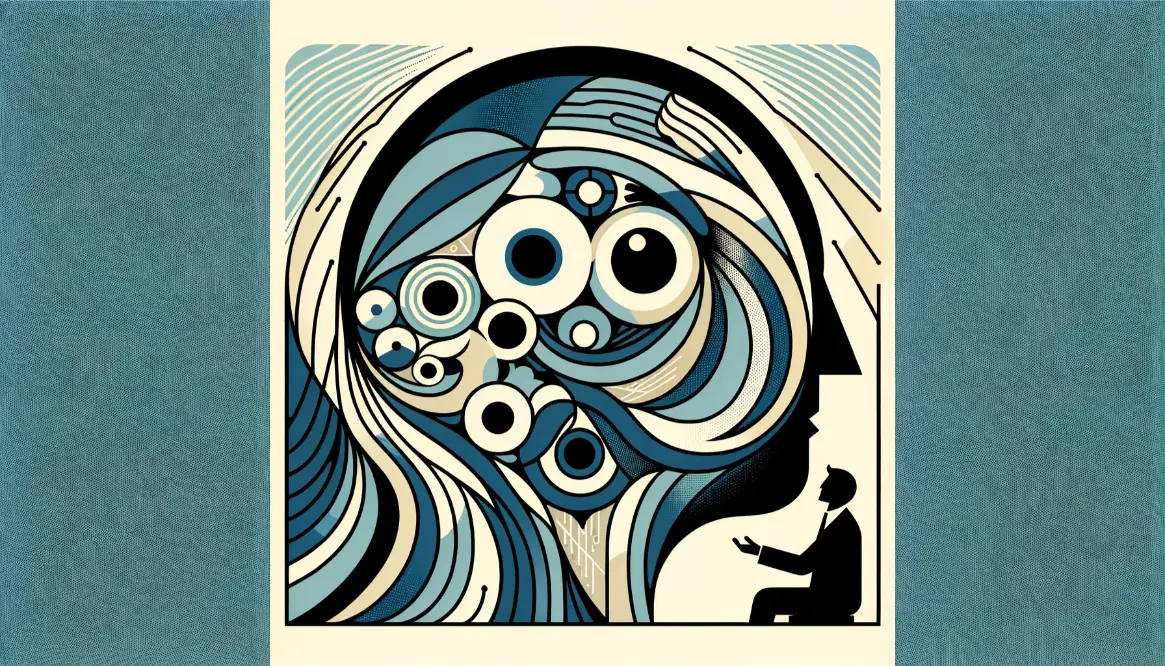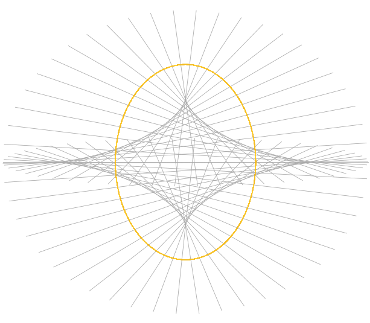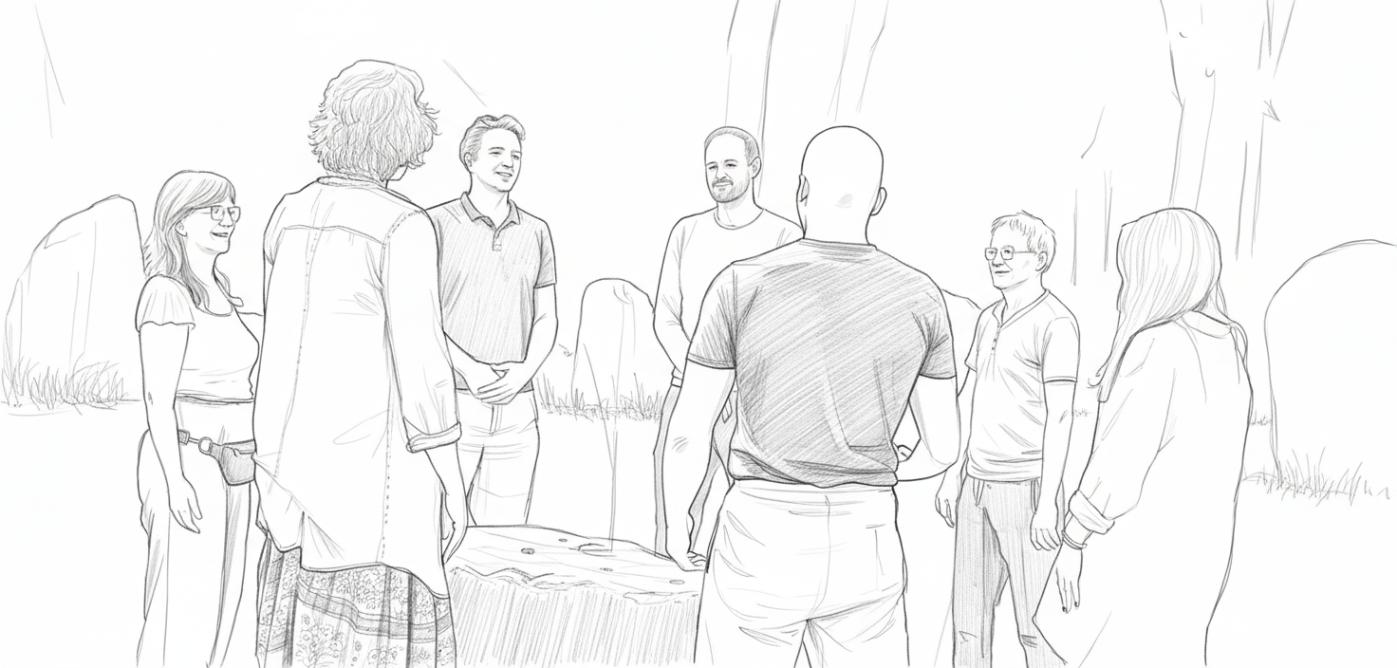Christopher Kabakis
Contributing Authors
Dmitrij Achelrod PhD
Christopher Kabakis
Contributing Authors
Dmitrij Achelrod PhD
HAKOMI is a mindfulness-based, body-oriented form of psychotherapy. It was developed in the 1970s by Ronald S. Kurtz (1943-2011) in the U.S. as a response to the limitations of traditional talk-based and cognitive forms of psychotherapy. It has been our experience at Evolute Institute that Hakomi merges Eastern philosophies and wisdom traditions on the one hand, and Western psychology on the other hand, to a new, more effective psychotherapeutic whole. This article delves into the synergistic relationship between Hakomi and psychedelic-assisted inner work, illustrating how these paths complement and enhance each other in the journey toward wholeness, integration and personal development.
1. Understanding Hakomi
Hakomi, pronounced Hah-co-me, is a Hopi Indian word that roughly translates to “How do you stand in relation to these many realms”? Hakomi is an approach to guided self-study using the vehicle of mindfulness to attune to our deepest, most fundamental qualities of being human. It seeks to empower us to hold our own vulnerability, pain, uncertainty and paradoxes with curiosity and compassion. Instead of trying to “fix something” that seems broken within us and go for a “war on self”, Hakomi operates under the guiding mantra of pausing and studying our troublesome inner parts first, and then gradually befriending them. Acceptance precedes change, as already Lao-Tzu attested: “If you want to shrink something, you must first allow it to expand. If you want to get rid of something, you must first allow it to flourish.” Hakomi tries to integrate Buddhist and Taoist wisdom with a modern neuroscientific understanding of our brains, focusing on experiential learning rather than mere theory and reflection. In Hakomi psychotherapy, the focus lies on granting space to our felt experience and not so much on intellectualization and cognition. Words and analysis are less important than the subtle signs that our body expresses.
In essence, Hakomi is psychodynamic and experiential technique and philosophy grounded in five core principles: mindfulness, organicity, non-violence, mind-body holism, and unity. These principles guide the therapeutic process and shape the relationship between therapist and client, fostering a compassionate exploration of the self through mindfulness to access subconscious material for transformation and healing.
-
Mindfulness
Hakomi utilizes Buddhism-informed mindfulness as a foundation for therapy and process work. It involves a state of heightened awareness where attention is focused on the present moment, allowing for the emergence of unconscious thoughts and feelings. When we are able to suspend our attachment to what we (think we) already know, we open ourselves to the depth and mystery of the present. This deep internal awareness enables the exploration of core beliefs and hidden emotional wounds and unconscious beliefs, facilitating processing, resolution and ultimately personal growth.
-
Organicity
Organicity in Hakomi reflects the view of human beings as self-organizing systems naturally inclined towards healing and wholeness. It respects the innate wisdom and healing capacity within each individual, emphasizing the belief that each person or organism possesses the ability to heal themselves and move towards the fulfillment of their potential. This is very aligned with what psychedelic researcher and pioneer Stanislav Grof called “innate healing intelligence” – the tendency of the organism to strive towards balance, wholeness, or harmony. In Hakomi, the human is not seen as a machine but as an intelligent, self-organizing system that cannot be fixed from the outside but only through tapping into its own inner creative intelligence and following cues from the present moment. In that sense, Hakomi therapy sessions do not come with a predefined agenda, but follow the natural processes, movements, and non-verbal expressions of the unfolding moment.
-
Non-Violence
Non-violence in Hakomi is about approaching the client’s experiences and defenses with gentleness and respect. This principle creates a safe space for clients to explore their inner world, viewing their defensive mechanisms as vital parts of their experience. This principle is foundational because in order to redirect our gaze inward, we need to feel safe to be the way we are. If we sense any form of danger or pressure from the outside, e.g. that we might be judged by the therapist, that a predefined agenda will be forced upon us, or that other forms of subtle physical or verbal violence might be inflicted upon us, we might resist and will direct our attention to the outside, but not to our inner world. The gentle and subtle approach of HAKOMI stands in big contrast to more forceful approaches such as “de-armoring” or some forms of expressive therapies from the 1960s (cf. also “The Hoffman Process vs. Psychedelic Retreat Programs”)
-
Mind-Body Holism
Western thinking and philosophy has been heavily influenced by the idea of separation of body and mind – ever since René Descartes’ declaration of the mind-body dualism. Hakomi, on the other hand, acknowledges the interconnectedness of mental and physical / bodily (somatic) experiences. It understands that our beliefs and emotions are often manifested in our bodily sensations, postures and movement impulses, using this mind-body integration to facilitate healing. We don’t just “have” bodies, we “are” bodies with our minds as only one expression of our embodied being. Hakomi views us as complex “body-mind systems” where any separation of body and mind is merely the artificial result of an analytical process. Any therapeutic approach that ignores our embodied nature will inevitably miss most of the picture and is limited in its effectiveness. The tracking and exploration of our somatic experience is thus a crucial feature of HAKOMI therapy.
-
Unity
The principle of unity in Hakomi views individuals as part of an interconnected whole, considering the relational aspects of one’s issues and fostering a sense of connectedness with others and the environment. Our lives unfold, so to speak, in a “participatory universe” (Morris Berman), where everything exists in a reciprocal interaction. This is in line with modern systemic approaches (in therapy, social work and in complexity sciences) as well as integral thinking (Ken Wilber). It also resonates well with Arthur Koestler’s concept of “holons”. “Holon” means that every thing/object as well as every idea/word is both an entity on its own, and a hierarchical part of a larger whole. For example, a cell in an organism is both a whole as a cell, and at the same time a part of the organism, a larger whole with an increased level of complexity. And that organism is in turn a part of larger, more complex wholes, e.g. social wholes (families, tribes, societies…) or ecosystems. This worldview has two important implications for the way in which Hakomi therapy is practiced: First, we can rest assured that there is an innate drive within each of us away from fragmentation towards wholeness – there is no need to “fix” or re-engineer ourselves, we rather have to create the right conditions where our inner intelligence can unfold. Second, the idea that we are holons means that any solution to our problem must be holistic, e.g. depression cannot be degraded to a purely biochemical imbalance of the brain, but is better be viewed as a multi-faceted symptom on potentially many levels, e.g. body, mind, spirit, community, work etc. Hakomi tries to account for many of these psychosocial factors.
2. How does HAKOMI therapy work?

3. What makes HAKOMI unique?

-
Non-Verbal Cues
Therapists in Hakomi are trained to observe and interpret non-verbal cues like posture, gesture, facial expressions, and tone of voice, as they often reveal more than words and can be indicators of underlying psychodynamic topics. This kind of “tracking” is an active form of witnessing and can be used for interventions, but it is also valuable to signal to the client that they are being seen and that people respond to them in an attuned way.
-
Probes
These are gentle, non-verbal acts (e.g. gestures or movements) or verbal suggestions or questions used while the client is in a state of mindfulness. Probes might involve asking the client to notice their feelings or reactions to certain words or phrases, helping to uncover hidden beliefs and emotions. Think of them as little “experiments” where you want to gauge the inner reactions of a client from all levels of awareness (bodily sensations, movement impulses, emotions, thoughts…). The intention is to elicit reactions that reveal unconscious material, including the client’s core beliefs and memories. For example, if the therapist sends the probe “Your are fully worthy and deserving of love” and the client reports back from a mindful state that there came a thought up upon hearing this probe that said “that’s not true”, or an emotion of shame, a movement impulse to turn away from the therapist, or a bodily sensation of contraction in the chest or so, then we might have found a self-limiting belief, a “barrier to nourishment” and can explore this deeper in the session. Note that unlike traditional talk therapy, Hakomi is explicitly encouraging the clients to note bodily and somatic experiences.
-
Bodywork / Somatic touch
This might include gentle touch or guiding the client through physical postures. Touch can also be thought of as experiments, but of a non-verbal kind (unlike the verbal probes). The aim is to explore and support the release of physical tension that is being held in the body and is related to psychological issues that the client reports.
-
Character Strategies
Hakomi therapists make sense of clients’ conditions by referring to a typology of character strategies. These are patterns of behavior, feeling, and thinking that people adopt, often unconsciously, in response to their life experiences. They are the coping and survival strategies we mostly unconsciously took on during our infancy and childhood following our intrinsic drive to remain unharmed, integrated (whole) and well resourced. Our character strategies hence do not pin-point our fundamental and pathological flaws of character and attest how “wrong” we are, but instead speak of our inner intelligence’s attempt to creatively adapt to overwhelming conditions in our lives. This gentle stance highlights again Hakomi’s non-violent approach towards therapy. Hakomi’s understanding of character strategies is rooted in developmental psychology, attachment theory, and object relations and has evolved from work of early pioneers like Wilhelm Reich, Alexander Lowen, David Shapiro and John Pierrakos. What distinguishes Hakomi’s character theory from other typologies of characters in psychology is its focus on somatic manifestations. In other words, Hakomi postulates that our body holds and expresses our psychological character strategies. The eight character patterns are: Sensitive/Withdrawn, Dependent/Endearing, Self-reliant, Tough/Generous, Charming/Seductive, Burdened/Enduring, Industrious/Over-focused, and Expressive/Clinging. Without going into detail on these here, we would just emphasize that those strategies are best considered as rooted in “commonly negotiated, developmental conflicts” and not fixed character types that can be used to classify people.
-
Transformation of Core Material
Once core beliefs and memories are uncovered, for example through experiments like probes, the therapist guides the client in processing and potentially transforming these beliefs into more adaptive and healthy ones. A key intervention in the processing phase is for example to provide the “missing experience”. This means that the therapist provides what has been organized out as unavailable at some point in the client’s life, e.g. the therapist could provide nourishing emotional support when the client is re-experiencing an inner child state where he was left alone and unsupported as a child. This new emotional reference experience of getting support might help transform the original undernourished state and open up new possibilities in the client’s life.
-
Integration of Experiences
The therapist helps the client integrate their discoveries into their everyday consciousness and life. This might involve discussing how newly uncovered beliefs and patterns affect their daily life and relationships. It might also include helping the client solidify new experiences such as being able to accept nourishment or simply recognizing the option to solicit support and nourishment when needed and practice doing so as well as taking it in.
4. Psychedelic-Assisted Inner Work
Psychedelic-assisted inner work, involving controlled use of substances like psilocybin mushrooms or truffles, MDMA, or LSD, leads to altered states of consciousness where deep-seated emotional issues and core beliefs can surface, offering opportunities for transformative healing. The spectrum of this psychoactive substance-supported modalities ranges from psychedelic-assisted psychotherapy to psychedelic retreats, and from 1:1 settings to group formats.
5. Exploring the Synergy between Hakomi and Psychedelic-Assisted Inner Work

What does the “synergy” look like?
The question is: when speaking of “synergy” does that mean:
a.) To ingest a psychedelic substance (in a low- to medium-high dose) during or in preparation of a HAKOMI psychotherapy session – as it is done in traditional psycholysis.
Or would it mean:
b.) To also do HAKOMI therapy as part of personal process work that happens over a longer period (several years) and that might include all kinds of modalities, such as bodywork, legal psychedelic work, coaching, and other therapeutic modalities beyond HAKOMI? In this sense different modalities can complement and re-inforce each other when it comes to psychological change, flexibilization, and growth.
One side note: In many jurisdictions many psychedelic substances are (still) not legal so currently in many countries people won’t be able to do a psychedelic-assisted HAKOMI session in a legal setting. People might, however, travel to countries like the Netherlands or Jamaica where many psychedelics are already legal today. And in many jurisdictions all over the world, from Australia to different U.S. states, psychedelic-assisted psychotherapy is legal or is in the process of being legalized. If the psychotherapist with the license and training to do psychedelic-assisted work is a HAKOMI practitioner, people could as well get to benefit from lawful psychedelic-supported HAKOMI sessions.
Four key considerations when combining HAKOMI and Psychedelics

-
Enhanced Mindfulness and Self-Awareness
Psychedelics can intensify mindfulness, enabling a deeper exploration of core material, making sessions particularly potent when combined with Hakomi’s mindful, exploratory approach.
-
Deep Emotional Processing
Both Hakomi and psychedelics facilitate deep emotional processing, with psychedelics bringing subconscious material to the surface and Hakomi providing a framework for exploring and integrating these experiences.
-
Accelerated Healing
The synergy of Hakomi’s gentle approach and the profound experiences induced by psychedelics can accelerate the developmental or processing (healing) and integration process, allowing for the rapid transformation of deep-seated emotional wounds.
-
Integration
Integration is crucial in both Hakomi and psychedelic therapy, involving the application of insights and experiences from sessions to one’s daily life. Hakomi’s focus on mindfulness and self-study provides an excellent framework for this integration process. Professional psychedelic retreat providers offer numerous integration sessions on-site and in the weeks and months after the psychedelic experience, both in a group and in 1:1 settings. See also “How to pick a psychedelic retreat that resonates with your personal values and beliefs”.
Conclusion
The integration of Hakomi therapy and psychedelic-assisted inner work represents a new frontier in psychotherapy, coaching and process work, offering pathways for profound healing and personal growth.1
This synergy combines the mindfulness, body-orientation and compassion of Hakomi with the transformative potential of psychedelics, promising deeper self-discovery, integration, expanded states and access to new levels or stages of growth.
And if we consider our developmental path generally as “being in our own process” that stretches over years, or even over our life time, and has different focus topics along the way at different times and stages, then both psychedelic-supported inner work and HAKOMI can offer a deep and, impactful way to promote this growth.
Please bear in mind that we do not provide medical advise and you should always seek assistance from a medical professional before making any decision about consuming psychedelics.

Dr. Dmitrij Achelrod,
co-founder Evolute Institute
LET'S HAVE A CHAT...
We invite you to schedule a call with us. Together, we can delve into any questions you might have. We can explore whether our psychedelic-assisted retreat program is right for you at this time.
1. Psychedelic Somatic Institute (PSI): A very interesting alternative approach that combines psychedelic therapy with somatic work is being developed by Saj Razvi at the Psychedelic Somatic Institute (Psychedelic Somatic Institute (PSI)). It’s called Psychedelic Somatic Interactional Psychotherapy. For more information, see www.psychedelicsomatic.org. ↩
Bibliography
Weiss, H., Johanson, G., & Monda, L. (Eds.). (2015). Hakomi mindfulness-centered somatic psychotherapy: A comprehensive guide to theory and practice. W. W. Norton & Company.
- The Hakomi Institute. (n.d.). The Hakomi Principles. Retrieved from [https://hakomiinstitute.com/]]
- GoodTherapy. (n.d.). Principles of Hakomi Body-Centered Therapy. Retrieved from [https://www.goodtherapy.org]
- The Embody Lab. (n.d.). Exploring the Hakomi Method of Mindful Psychotherapy. Retrieved from [https://www.theembodylab.com/blog/exploring-the-hakomi-method-of-mindful-psychotherapy]
- Wikipedia. (n.d.). Hakomi. Retrieved from [https://en.wikipedia.org/wiki/Hakomi]
- Mind.Help. (n.d.). Hakomi Therapy: How Can It Heal You, Benefits, And FAQs. Retrieved from [https://mind.help/topic/hakomi-therapy/]
- The Human Condition. (n.d.). Hakomi Therapy: Overview and Effectiveness. Retrieved from [https://thehumancondition.com/hakomi-therapy/]
- Hakomi Institute of Australia. (n.d.). About Hakomi — Hakomi Mindful Somatic Psychotherapy. Retrieved from [https://hakomi.com.au/]
- Maya Health. (2022). How Hakomi Therapy Supports Psychedelic Healing. Retrieved from [https://www.mayahealth.com/blog/how-hakomi-therapy-supports-psychedelic-healing]
- Evolute Institute. (n.d.). Articles on Psychedelics and Psychotherapy. Retrieved from [https://evolute-institute.com/blog-insights/]




